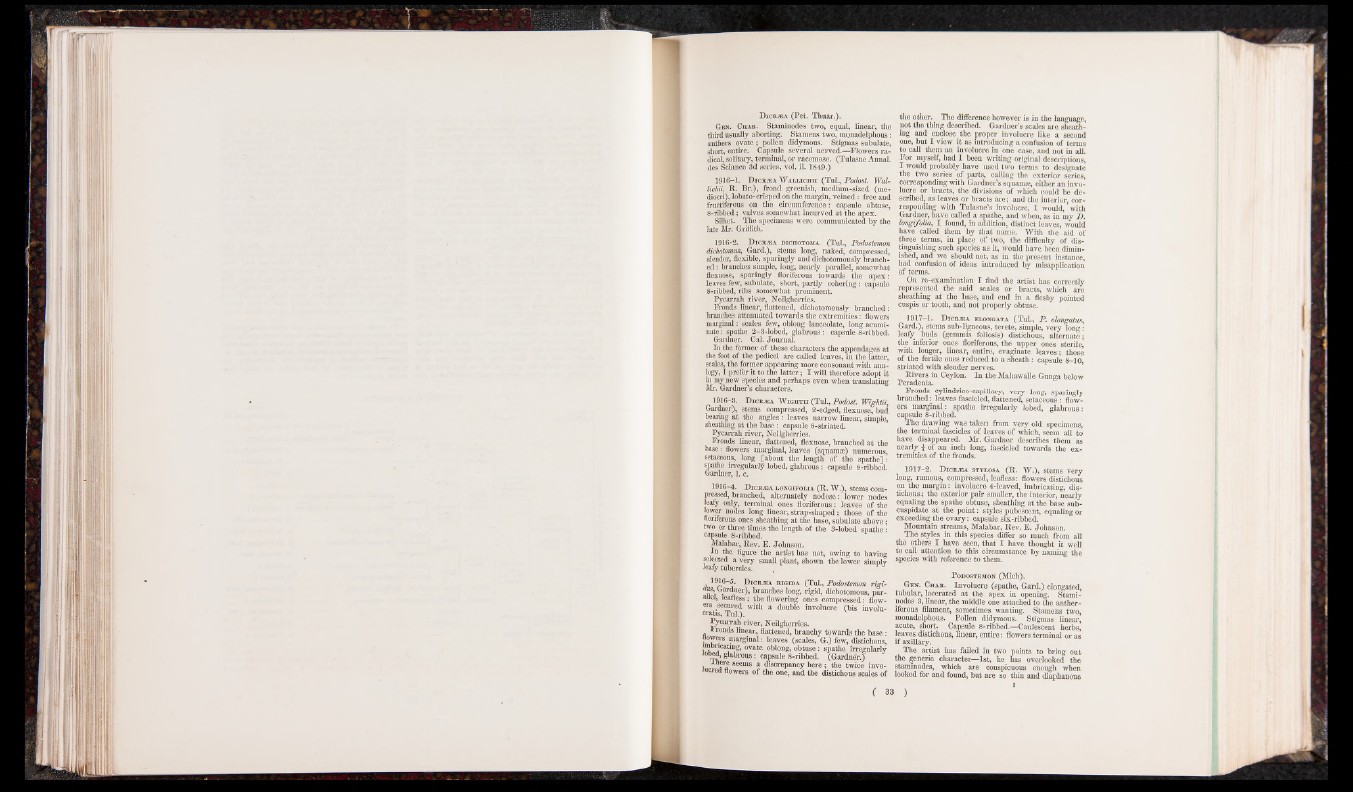
Dicr.zba (Pet. Thuar.).
Gbn. Char. Staminodes two, equal, linear, the
third usually aborting. Stamens two, monadelphous:
anthers ovate; pollen didymous. Stigmas subulate,
short, entire. Capsule several neiVed.—Flowers ra dical,
solitaiy, terminal, or racemose. (Tulasne Annal.
des Sciance 3d series, vol. ii. 1849.)
1916-1. D icr-zba W a lm c bh (Tul., Podost. Wal-
lickii, R. Br.), frond greenish, medium-sized (me-
diocri), lobato-crisped on the margin, veined: free and
fructiferous on the circumference: capsule obtuse,
8-ribbed; valves somewhat incurved at the apex.
Silhet. The specimens were communicated by the
late Mr. Griffith.
1916-2. DiCRiEA dichotoma (Tul., Podostemon
dichotomies, Gard.), stems long, naked, compressed,
slender, flexible, sparingly and dichotomously branched
: branches simple, long, nearly parallel, somewhat
flexuose, sparingly floriferous towards the ap e x :
leaves few, subulate, short, partly cohering: capsule
8-ribbed, ribs somewhat prominent.
Pycarrah river, Neilgherries.
Fronds linear, flattened, dichotomously branched:
branches attenuated towards the extremities: flowers
marginal: scales few, oblong lanceolate, long acuminate
: spathe 2-3-lobed, glabrous: capsule 8-ribbed.
Gardner. Cal. Journal.
In the former of these characters the appendages at
the foot of the pedicel are called leaves, in the latter,
scales, the former appearing more consonant with analogy,
I prefer it to the latter; I will therefore adopt it
in my new species and perhaps even when translating
Mr. Gardner’s characters.
1916-3. DiCRiEA Wighth (Tul., Podost. Wightii,
Gardner), stems compressed, 2-edged, flexuose, bud
bearing at the angles: leaves narrow linear, simple,
sheathing at the base: capsule 8-striated.
Pycarrah river, Neilgherries.
Fronds linear, flattened, flexuose, branched at the
base: flowers marginal, leaves (squamje) numerous,
setaceous, long [about the length of the spathe]:
spathe irregularly lobed, glabrous: capsule 8-ribbed.
Gardner, 1. c.
yiwaeu, uranenea, alternately noaose: lower nodes
leafy only, terminal ones floriferous: leaves of the
lower nodes long linear, strap-shaped; those of the
floriferous ones sheathing at the base, subulate above;
two or three times the length of the 3-lobed spathe:
capsule 8-ribbed.
Malabar, Rev. E. Johnson.
In the figure the artist has not, owing to having
selected a very small plant, shown the lower simply
leafy tubercles. ,
, * § B f DiCRiEA rigida (TuL, Podostemon rigi-
n i W i i l branches long, rigid, dichotomous, parallel,
leafless; the flowering ones compressed: flowers
secured with a double involucre (bis involu-
eratis, Tul.).
Pycarrah river, Neilgherries.
Fronds linear, flattened, branchy towards the b ase:
flowers marginal: leaves (scales, G.) few, distichous,
imbricating, ovate oblong, obtuse: spathe irregularly
lobed, glabrous: capsule 8-ribbed. (Gardner.)
h » a # seems a discrepancy h ere; the twice invo-
crea flowers of the one, and the distichous scales of
the other. The difference however is in the language,
not the thing described. Gardner’s scales are sheathing
and enclose the proper involucre like a second
one, but I view it as introducing a confusion of terms
to call them an involucre in one case, and not in all.
For myself, had I been writing original descriptions,
I would probably have used two terms to designate
the two series of parts, calling the exterior series,
corresponding with Gardner’s squama*, either an involucre
or bracts, the divisions of which could be described,
as leaves or bracts are; and the interior, corresponding
with Tulasne’s involucre, I would, with
Gardner, have called a spathe, and when, as in my D.
longifolia, I found, in addition, distinct leaves, would
have called them by that name. With the aid of
three terms, in place of two, the difficulty of distinguishing
such species as it, would have been diminished,
and we should not, as in the present instance,
had confusion of ideas introduced by misapplication
of terms.
On re-examination I find the artist has correctly
represented the said scales or bracts, which are
sheathing at the base, and end in a fleshy pointed
cuspis or tooth, and not properly obtuse.
1917-1. DiCRiEA BLONGATA (TuL, P. cloflgatus,
Gard.), stems sub-ligneous, terete, simple, very long:
leafy buds (gemmis foliosis) distichous, alternate;
the inferior ones floriferous, the upper ones sterile,
with longer, linear, entire, evaginate leaves; those
of the fertile ones reduced to a sheath: capsule 8-10,
striated with slender nerves.
Rivers in Ceylon. In the Mahawalle Gunga below
Peradenia.
Fronds cylindrico-capillary, very long, sparingly
branched: leaves fascicled, flattened, setaceous: flowers
marginal: spathe irregularly lobed, glabrous:
capsule 8-ribbed.
The drawing was taken from very old specimens,
the terminal fascicles of leaves of which, seem all to
have disappeared. Mr. Gardner describes them as
nearly £ of an inch long, fascicled towards the extremities
of the fronds.
1917-2. DiCRiEA stylosa (R. W.), stems very
long, ramous, compressed, leafless: flowers distichous
on the margin: involucre 4-leaved, imbricating, distichous;
the exterior pair smaller, the interior, nearly
equaling the spathe obtuse, sheathing at the base sub-
cuspidate at the point: styles pubescent, equaling or
exceeding the ovary: capsule six-ribbed.
Mountain streams, Malabar, Rev. E. Johnson.
The styles in this species differ so much from all
the others I have seen, that I have thought it well
to call attention to this circumstance by naming the
species with reference to them.
Podostemon (Mich). '
G en. Ch a r . Involucre (spathe, Gard.) elongated,
tubular, lacerated at the apex in opening. Staminodes
3, linear, the middle one attached to the anther-
iferous filament, sometimes wanting. Stamens two,
monadelphous. Pollen didymous. Stigmas linear,
acute, short. Capsule 8-ribbed.—Caulescent herbs,
leaves distichous, linear, entire: flowers terminal or as
if axillary.
The artist has failed in two points to bring out
the generic character—1st, he has overlooked the
staminodes, which are conspicuous enough when
looked for and found, but are so thin and diaphanous